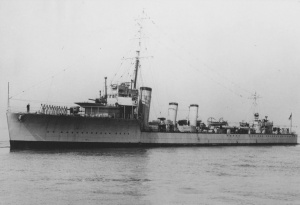HMAS Anzac (I) was the last of six modified Kempenfelt Class destroyer flotilla leaders, based on the Marksman Class, built for the Royal Navy (RN) under the Emergency War Programme in the shipyards of Denny Bros Ltd in Dumbarton, Scotland.
After commissioning into the RN on 24 April 1917 as HMS Anzac, it became leader of the 14th Destroyer Flotilla based at Scapa Flow and conducted antisubmarine operations in the North Sea and the English Channel.
It suffered storm damage in August 1918 which stove in its boats and necessitated the replacement of its two small funnels. At the conclusion of hostilities, it was placed into reserve and laid up at Portsmouth.
In 1919, Anzac, along with five S Class destroyers, was gifted to the Royal Australian Navy (RAN) by the British Government. It was commissioned into the RAN as HMAS Anzac under the command of Commander SH Simpson, DSO, RN on 27 January 1920 and on 26 February it departed Plymouth for Australia, and inauspiciously lost a propeller blade forcing its to return to Plymouth. With its propeller replaced, it departed Plymouth again on 10 March and arrived in Sydney on 29 April 1920, via Gibraltar, Suez, Aden, Mumbai, Colombo, Singapore, Sourabaya and Thursday Island. That May, Anzac transferred HRH Edward, the Prince of Wales (who became HRH King Edward VIII in 1936) from HMS Renown to Princes Pier for his visit to Melbourne.
Anzac spent the majority of its first RAN commission in eastern and southern Australian waters though it visited New Guinea in June and July 1924, and again in May 1926. In December 1922, its Commanding Officer, Lieutenant Commander Reginald C Creer, RAN, had the rare honour of handing over command to his twin brother, Lieutenant Commander Herbert V Creer, RAN.
Anzac decommissioned on 4 August 1926 and recommissioned on 10 January 1928 under the command of Commander CH Ringrose, RN. On 9 June 1928 it stood by off the Queensland coast as Sir Charles Kingsford-Smith and his crew approached Brisbane on their historic flight across the Pacific Ocean in the Fokker F.VIIb/3m tri-motor monoplane, Southern Cross. Anzac was again in attendance off the New South Wales coast when Kingsford-Smith made the first nonstop trans-Tasman flight in Southern Cross that September.
In July 1930, Anzac became the first command of the iconic RAN officer, Lieutenant Commander (later Vice Admiral Sir) John Collins, RAN, and, under his command, visited New Guinea and the Solomon Islands that September. It was decommissioned for the third and final time on 30 July 1931 and placed into reserve. It was sold for scrap on 8 August 1935 and on 7 May 1936, its hulk was towed out of Port Jackson and scuttled.
Specifications
 |
| Class |
Modified Kempenfelt Class |
|---|---|
| Type |
Destroyer |
| Pennant |
G90 |
| Builder |
Denny Bros Ltd, Dumbarton, Scotland |
| Laid Down |
31 January 1916 |
| Launched |
11 January 1917 |
| Commissioned |
27 January 1920 |
| Decommissioned |
30 July 1931 |
| Fate |
Sold 8 August 1935, scuttled outside of Port Jackson 7 May 1936 |
| Dimensions & Displacement | |
| Displacement | 1660 tons |
| Length | 325 feet |
| Beam | 31 feet 10 inches |
| Draught | 12 feet 1.5 inches |
| Performance | |
| Speed | 34 knots |
| Range | 2500 miles at 15 knots |
| Complement | |
| Crew | 122 |
| Propulsion | |
| Machinery | Brown-Curtis geared turbines, 3 screws |
| Horsepower | 36,000 sph |
| Armament | |
| Guns |
|
| Torpedoes | 4 x 21-inch torpedo tubes in two twin mounts |
